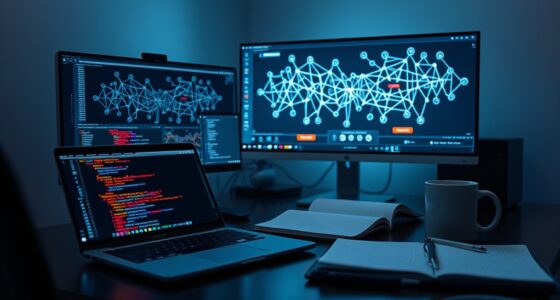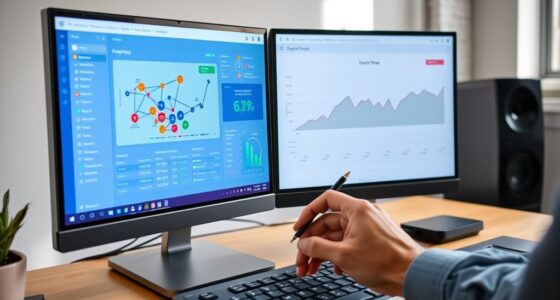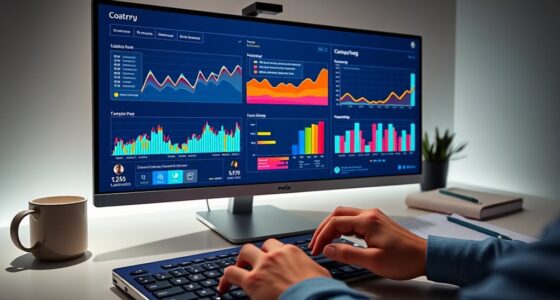Event tracking captures specific user actions like clicks, downloads, or video plays, giving detailed insights into individual behaviors. Session tracking groups all activities within a set timeframe, providing an overview of a user’s journey across multiple interactions. Understanding these differences helps you choose the right method to analyze user engagement effectively. Keep exploring to uncover how each tracking approach can boost your data accuracy and strategic decisions.
Key Takeaways
- Event tracking records specific user actions for detailed, real-time insights, while session tracking groups all activities within a time frame for broader analysis.
- Event tracking uses embedded scripts or tags to capture individual actions, whereas session tracking relies on cookies or device fingerprinting to link multiple interactions.
- Event tracking offers granular data on user behaviors, ideal for optimizing content; session tracking provides an overview of user journeys and flow.
- Privacy considerations differ: cookies are transparent but less persistent, while device fingerprinting is passive and raises privacy concerns.
- Choosing between them depends on analysis goals: event tracking for detailed actions, session tracking for overall user flow and engagement.
Defining Event Tracking and Session Tracking
While both event tracking and session tracking are essential for analyzing user behavior, they serve different purposes. Event tracking records specific actions users take, like clicks or video plays, providing detailed insights for real-time analytics. It helps you see exactly what users do, when, and how often. Session tracking, on the other hand, groups all user activities within a defined timeframe into a single session, giving a broader view of user engagement. It’s especially useful for cross device tracking, as it allows you to connect user behaviors across multiple devices during one visit. Understanding the differences between these methods enables marketers to better interpret user data and tailor their strategies accordingly. Together, these methods help you understand both individual actions and overall user journeys, enabling more targeted marketing and improved user experiences.
Purpose and Use Cases for Each Method
Event tracking is best for monitoring specific user actions, like clicks or downloads, to understand individual behaviors. Session tracking provides a broader view of the overall user journey across multiple interactions. Knowing when to use each method helps you gather meaningful insights tailored to your goals. Additionally, understanding home furnishings can help optimize user environments by improving comfort and safety.
Event Tracking: Specific User Actions
Tracking specific user actions provides valuable insights into how visitors interact with your website or app. This method helps you understand user behavior at a granular level, enabling precise data segmentation. For example, you can monitor clicks, form submissions, video plays, or downloads, revealing what engages users most. Use event tracking to optimize content, streamline navigation, and improve conversions. Here’s a quick comparison:
| Use Case | Benefit |
|---|---|
| Clicks on buttons or links | Identify popular features or pain points |
| Form submissions | Measure lead generation and user interest |
| Video plays | Assess engagement with multimedia content |
| Downloads | Track resource consumption and content interest |
| Social shares | Understand content virality and reach |
Event tracking offers targeted insights, helping you refine user experiences effectively. Additionally, understanding how different events relate to overall user engagement can guide strategic improvements, especially when combined with content analysis to optimize user flow and retention.
Session Tracking: Overall User Journey
Understanding the overall user journey is essential for gaining an all-encompassing view of how visitors interact with your website or app over time. Session tracking helps you see this by capturing user activity within a single visit, providing insights into navigation patterns and engagement levels. It offers real-time updates, allowing you to monitor active sessions and respond promptly to user behavior. Additionally, session tracking supports cross device tracking, revealing how users switch between devices during their journey. This extensive perspective helps identify drop-off points, optimize user flow, and improve overall experience. By focusing on the entire session, you can better understand long-term engagement and tailor your strategies to meet user needs at different touchpoints. Moreover, understanding the profound impact of fatherhood can inspire strategies to foster community and support among users.
How Data Is Collected and Recorded
You’ll see that data collection varies between event and session tracking, with each method capturing information differently. Event data is recorded whenever specific actions happen, while session identification groups activity into continuous periods. Understanding these tracking methods helps you choose the right approach for accurate data recording. Additionally, tracking methods can influence how you analyze user engagement and behavior.
Event Data Capture
Event data capture involves collecting information about user interactions as they happen on your website or app. This process enables you to track specific actions like clicks, form submissions, or page views in real time, providing immediate insights. To do this effectively, you rely on various tools and techniques, such as embedded scripts or tracking pixels. Key considerations include:
- Ensuring data is captured accurately and promptly for real time updates
- Balancing detailed tracking with privacy concerns and compliance
- Choosing between server-side or client-side data collection methods
- Handling large volumes of data efficiently without compromising performance
- Incorporating essential oils for data security, which can help create a sense of calm and focus during complex data management tasks.
Session Identification Methods
Session identification methods determine how your website or app recognizes and groups user interactions into individual sessions. You often rely on cookies tracking, where small data files stored in users’ browsers identify returning visitors and link their activities. Cookies can be session-based or persistent, helping you track user behavior accurately over time. Another method is device fingerprinting, which gathers information about a user’s device, browser, and settings to create a unique profile. This technique allows you to identify users even if they delete cookies or switch browsers. Both methods help you maintain session continuity, but each has its strengths and limitations. Choosing the right approach depends on your tracking goals, privacy considerations, and the level of accuracy you need for session recording. Understanding user behavior can further enhance your ability to select the most effective session tracking method.
Tracking Methodology Differences
Both cookies and device fingerprinting gather user data in distinct ways, which directly impacts how information is collected and recorded. Cookies store small data files on your device, making data collection straightforward but raising privacy concerns. Device fingerprinting analyzes unique device attributes—like screen resolution and browser type—without storing files, offering higher data accuracy but sparking privacy worries.
Key methodology differences include:
- Cookies rely on stored data, susceptible to deletion or blocking.
- Fingerprinting collects passive, persistent device info.
- Cookies are user-controlled, often easier to manage.
- Fingerprinting operates covertly, making it harder to detect or block.
Understanding these differences helps you grasp how each method balances data accuracy with privacy concerns, shaping effective tracking strategies.
Differentiating User Interactions and Engagement
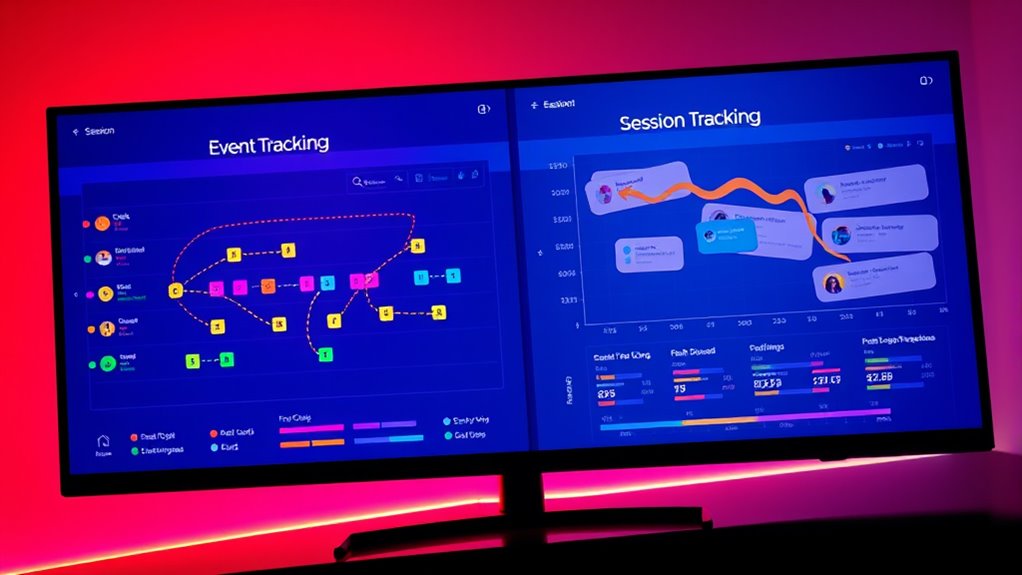
Understanding the difference between user interactions and engagement is crucial for accurately analyzing how visitors interact with your website or app. User interactions are specific actions, like clicks or form submissions, while engagement reflects the overall level of interest and involvement. To visualize this, consider the following:
| User Interaction | Engagement Level | Example |
|---|---|---|
| Clicking Button | Low | Single visit, minimal actions |
| Scrolling Page | Moderate | Browsing content, some interactions |
| Playing Video | High | Deep involvement, longer session |
| Adding to Cart | High | Intent to convert, behavioral segmentation |
| Leaving Quickly | Low | Bounce, low engagement |
Using real-time analytics helps you monitor these behaviors instantly, enabling targeted optimization based on engagement levels and interaction types. Recognizing content performance can further refine your strategy to foster higher engagement.
Impact on Analytics and Reporting
Tracking user interactions and engagement levels directly influences your analytics and reporting accuracy. When you utilize event tracking, you gain detailed insights into individual actions, enabling real-time analysis that helps you respond swiftly to user behavior. Conversely, session tracking offers a broader view of user journeys, but may lack immediate granularity. This impacts your ability to maintain cross-platform consistency, especially when users switch devices or browsers. To optimize your analytics, consider how each method affects:
- Data granularity and depth
- Real-time decision-making capabilities
- Cross platform data alignment
- Overall reporting clarity
Choosing the right approach ensures your reports are precise, timely, and reflective of actual user behavior, supporting better strategic decisions and improved user experiences. Incorporating merchant services into your tracking strategies can further enhance your understanding of transaction patterns and customer behavior.
Implementation Complexity and Requirements
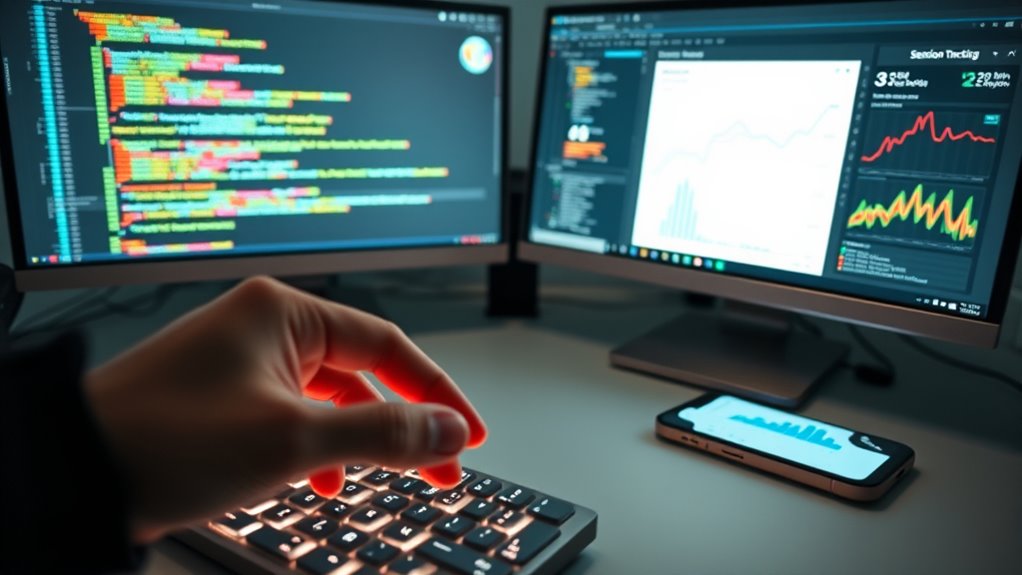
Implementing event tracking typically requires setting up specific code snippets or tags on individual user actions, which can involve detailed planning and technical expertise. The setup complexity varies depending on the platform and the number of events you want to monitor, often demanding a clear strategy for tagging. You’ll need to understand the technical requirements, such as integrating with your website’s code or analytics tools, and guaranteeing proper data collection. This process may involve customizing scripts or using tag management systems, adding to the technical overhead. In contrast, session tracking usually involves fewer setup steps, often relying on built-in features of analytics platforms. Overall, event tracking’s implementation complexity demands more time, technical skills, and precise configuration to ensure accurate and exhaustive data collection. Additionally, understanding the psychological aspects of user behavior can help optimize your tracking strategies for better insights.
Limitations and Common Challenges
While setting up event and session tracking can enhance your data insights, both methods come with notable limitations. Privacy concerns are a major challenge, as users become more wary of data collection, which can lead to incomplete data. Data accuracy also suffers due to tracking errors, ad-blockers, or misconfigured tags. Additionally, you might encounter issues like cross-device tracking inconsistencies, which skew results. Finally, reliance on third-party cookies can diminish tracking effectiveness as browsers tighten privacy controls. These challenges require careful consideration to ensure your analytics remain reliable. Addressing privacy concerns involves transparent policies, while improving data accuracy demands regular audits and updates. Moreover, understanding the Eye Patch Benefits can help tailor your skincare routines to mitigate skin irritation or dependency issues, emphasizing the importance of tailored approaches. Recognizing these common challenges helps you adapt your tracking strategies for more meaningful insights.
Choosing the Right Tracking Method for Your Goals
Choosing the right tracking method depends on your specific goals and the type of insights you need. If you’re focused on understanding individual actions or user engagement, event tracking is ideal, as it captures specific interactions while respecting data privacy. Conversely, session tracking provides a broader view of user behavior within a visit, useful for analyzing overall flow. Consider privacy concerns and data privacy regulations when selecting your method. Event tracking often involves collecting granular data, so ensure your approach complies with privacy standards like GDPR or CCPA. Session tracking, being less invasive, might better suit privacy-sensitive environments. Ultimately, align your choice with your goals, balancing the level of detail needed against privacy concerns and existing data privacy policies. Additionally, understanding how projector technologies affect image quality can help optimize your data presentation and visualization strategies.
Frequently Asked Questions
How Do Event and Session Tracking Influence User Privacy?
When you track events and sessions, it impacts user privacy by collecting data that could reveal personal behavior. You need to prioritize data privacy by implementing robust consent management, ensuring users agree before tracking begins. This not only complies with regulations but also builds trust. By being transparent about what you collect and why, you help protect user information and respect their privacy rights throughout the tracking process.
Can Both Tracking Methods Be Used Simultaneously?
Yes, you can use both tracking methods simultaneously. This tracking compatibility allows you to gather complete insights by combining event tracking’s detailed user actions with session tracking’s overall user journey. Data synchronization between these methods ensures your analytics stay accurate and cohesive. Using both together helps you better understand user behavior, optimize experiences, and make informed decisions without compromising data integrity.
What Are the Best Practices for Integrating Both Tracking Types?
You might think combining tracking methods is straightforward, but ironically, it’s all about balancing tracking compliance and privacy implications. To integrate both effectively, you should clearly define your goals, guarantee transparent user consent, and implement robust data security. Regularly review your setup to stay compliant with regulations like GDPR. This way, you respect user privacy while gaining insightful data, proving that smarter tracking can coexist with privacy-conscious practices.
How Do Tracking Methods Affect Data Storage and Processing?
Tracking methods directly impact data aggregation and storage optimization. Event tracking captures specific actions, leading to detailed data that requires more storage and complex processing. Session tracking summarizes user activity, reducing data volume and simplifying processing. You must choose methods that balance granularity with storage capacity, ensuring efficient data handling. Properly managing these methods helps optimize storage and enables smoother data processing for better insights.
Are There Industry-Specific Scenarios Favoring One Method Over the Other?
You might think one tracking method fits all, but industry-specific analytics show otherwise. For example, e-commerce platforms benefit from session tracking to understand entire shopping journeys, while mobile apps often prefer event tracking for detailed user actions. Platform-dependent tracking influences this choice too. By choosing the right method for your industry, you’ll get clearer insights, making data-driven decisions easier and more accurate.
Conclusion
Choosing between event tracking and session tracking hinges on your specific goals. While some may think session tracking offers a broader view, event tracking provides granular insights into user interactions. Don’t overlook the complexity—implementing the right method necessitates understanding your data needs. By aligning your tracking approach with your analytics objectives, you ensure more accurate, actionable insights, ultimately empowering you to optimize user experience and achieve your business goals effectively.

